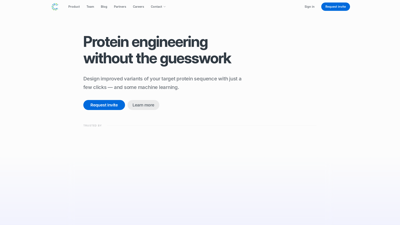Cradle is revolutionizing the field of protein engineering by leveraging advanced machine learning techniques to simplify the design of improved protein variants. With a user-friendly interface, researchers can generate optimized protein sequences in just a few clicks, significantly reducing the time and effort involved in traditional protein engineering methods. Cradle's innovative platform not only enhances the efficiency of protein design but also ensures that users maintain full ownership of their intellectual property. Whether you are working on enzymes, vaccines, or antibodies, Cradle provides the tools you need to succeed in your biotech projects.
Cradle
Features of Cradle
1. User-Friendly Interface
Cradle is designed to be intuitive, allowing users to easily navigate through the protein design process. The platform enables researchers to set up assays and objectives quickly, making it accessible even for those new to protein engineering.
2. Machine Learning Integration
By utilizing machine learning algorithms, Cradle learns from each experimental round, improving the quality of generated protein variants over time. This feature ensures that users receive better results with every iteration, ultimately leading to more successful experiments.
3. Multi-Property Optimization
Cradle allows users to optimize multiple properties of proteins simultaneously. This capability saves time and accelerates the research process, enabling scientists to focus on other critical aspects of their projects.
4. Secure Data Management
With Cradle, users can rest assured that their sequences and experimental data are kept private and secure. The platform employs bank-grade security measures and ensures that users retain full ownership of their intellectual property.
5. Seamless Integration with Lab Workflows
Cradle fits seamlessly into existing lab workflows, allowing users to import assay data from ongoing projects or start fresh with a single protein sequence. This flexibility enhances productivity and streamlines the research process.
6. Performance Scoring
Each generated protein sequence comes with a predicted performance score, providing users with valuable insights into the expected outcomes of their experiments. This feature helps researchers make informed decisions about which variants to test in the lab.
7. Support for Various Applications
Cradle is versatile and supports a wide range of applications, including enzyme design, vaccine development, peptide synthesis, and antibody engineering. This makes it an invaluable tool for biotech teams working on diverse projects.
Frequently Asked Questions about Cradle
What is Cradle?
Cradle is a protein engineering platform that uses machine learning to help researchers design improved variants of protein sequences quickly and efficiently.
How does Cradle work?
Users can set up assays and objectives, generate sequences, test them in the lab, and import lab results back into the platform. Cradle learns from each round of experiments to enhance future designs.
Is my data secure with Cradle?
Yes, Cradle employs bank-grade security measures to ensure that your data is kept private and secure. You retain full ownership of your intellectual property.
Can I optimize multiple properties at once?
Absolutely! Cradle allows you to optimize multiple properties of proteins simultaneously, which significantly speeds up the research process.
Who can benefit from using Cradle?
Cradle is designed for biotech teams, researchers, and scientists working in various fields, including enzyme design, vaccine development, and antibody engineering. It is suitable for both experienced professionals and those new to protein engineering.
